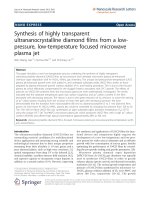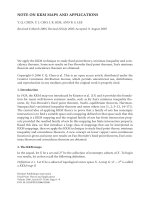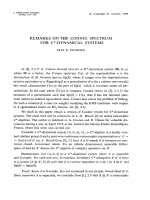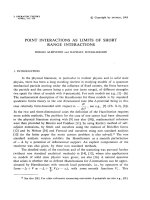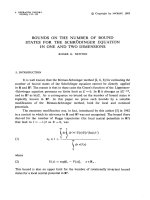Báo cáo toán học: "Note on highly connected monochromatic subgraphs in 2-colored complete graphs" docx
Bạn đang xem bản rút gọn của tài liệu. Xem và tải ngay bản đầy đủ của tài liệu tại đây (81.46 KB, 5 trang )
Note on highly connected monochromatic subgraphs
in 2-colored complete graphs
Shinya Fujita
∗
Colton Magnant
†
Submitted: Jul 25, 2009; Accepted: Nov 13, 2009; Published: Jan 12, 2011
Mathematics Subject Classification: 05C15, 05C40
Abstract
In this note, we improve upon some recent results concerning the existence of
large monochromatic, highly connected subgraphs in a 2-coloring of a complete
graph. In particular, we show that if n ≥ 6.5(k − 1), then in any 2-coloring of the
edges of K
n
, there exists a monochromatic k-connected subgraph of order at least
n −2(k −1). Our result improves upon several recent results by a variety of authors.
1 Introduction
It is easy to see that for any graph G, either G or its complement is connected. This
is equivalent to saying there exists a connected color in any 2-coloring of K
n
. However,
when we try to find a subgraph with higher connectivity, we cannot hope to find such
a spanning subgraph. In order to see this, consider the following example. All standard
notation comes from [3].
Consider the following example from [1]. Let G
n
= H
1
∪ · · · ∪ H
5
where H
i
is a red
complete gra ph K
k−1
for i ≤ 4 and H
5
is a red K
n−4(k−1)
where n > 4(k − 1). To this
structure, we add all possible red edges between H
5
, H
1
and H
2
and from H
1
to H
3
and
from H
2
to H
4
. All edges not already colored in red are colored in blue. In either color,
there is no k-connected subgraph of order larger than n − 2(k − 1).
Since a spanning monochromatic subg raph is more than we could hope for, we consider
finding a highly connected subgraph that is as large as possible. Along this line, Bollob´as
and Gy´arf´as proposed the following conjecture.
Conjecture 1 ([1]) For n > 4(k − 1), every 2-coloring of K
n
contains a k-connected
monochromatic subgraph with at least n − 2(k − 1) vertices.
∗
Department of Mathematics, Gunma National Colleg e of Technology. 580 Toriba , Maebashi, Gunma,
Japan 371-8530. Supported by JSPS Grant No. 20740068
†
Department of Mathematics, Lehig h University, 27 Memorial Dr, W. Bethlehem, PA, USA, 18015.
the electronic journal of combinatorics 18 (2011), #P15 1
In order to see that the bound on n is the best possible, consider the example G
n
above with n = 4(k − 1) (so H
5
= ∅). In [1], the authors showed that this conjecture is
true for k ≤ 2. Also, in [4], Liu, Morris and Prince showed the conjecture holds for k = 3,
but for other cases, it remains open. As a weaker result, in [6] the authors proved the
following.
Theorem 1 ([6]) If n ≥ 13k −15 then every 2-coloring of K
n
contains a monochromatic
k-connected subgraph of order at least n − 2(k − 1).
In a related result, Bollob´as and Gy´arf´as also proved t he following.
Theorem 2 ([1]) If Conjecture 1 holds for 4(k − 1) < n < 7(k − 1) then Conjecture 1 is
true.
In this note, we improve both of these results as follows:
Theorem 3 If n > 6.5(k − 1) then any 2-coloring of K
n
contains a monochromatic k-
connected subgraph of order at least n − 2(k − 1).
By improving the constant from 13 to 6.5, we also slightly improve other results from
[5] in some cases. As these improvements are very minor, we omit details. Since any k-
connected graph has the minimum degree at least k, we immediately obtain the following
corollary.
Corollary 4 If n > 6.5(k − 1), then any 2-coloring of K
n
contains a monochromatic
subgraph of order at least n − 2(k − 1) with the minimum degree at least k.
This corollary slightly improves a result in [2], which deals with the monochromatic
large subgraph with a specified minimum degree in general graphs. When we focus on
complete graphs, their work shows that the conclusion holds if n ≥ 7k + 4.
2 Proof of Theorem 3
Consider a 2-coloring G of K
n
with the colors red and blue. The proof proceeds by
induction on k. The cases for k ≤ 2 follow fro m [1] and the case k = 3 follows from [4] but
we will not need this assuption so we simply suppose k ≥ 3. By induction, there exists a
(k −1)-connected subgraph in one color (suppose red) of order at least n−2(k −2). If this
subgraph is k-connected, this is a desired subgraph so we may assume the connectivity is
exactly k − 1.
Let G
r
be the largest (k − 1)-connected red subgraph and consider a minimum cutset
C (of order k − 1) of G
r
. Let A
C
and B
C
be a bipartition of the vertices of G
r
\ C such
that A
C
(and likewise B
C
) is the union of vertices in components of G
r
\ C and we choose
such unions with |A
C
| ≥ |B
C
| and |B
C
| maximum. Choose such a cutset C so that |B
C
|
the electronic journal of combinatorics 18 (2011), #P15 2
is maximized and define A
′
= A
C
and B
′
= B
C
. By definition, all edges between A
′
and
B
′
are blue. This forms a complete bipartite graph in blue. Define D
′
= G \ G
r
.
First suppose |B
′
| ≥ k, which implies that this blue complete bipartite graph is k-
connected. Note that |D
′
| ≤ 2(k − 2) and, since |G
r
| is maximum, every vertex in D
′
has a t most k − 2 red edges to G
r
. This means that each vertex of D
′
must have at
least |G
r
| − (k − 2) blue edges to G
r
. More sp ecifically, each vertex must have at least
|A
′
∪B
′
|−(k−2) > k blue edges to A
′
∪B
′
(since n ≥ 5k−7). This means that A
′
∪B
′
∪D
′
induces a blue k-connected gr aph of order exactly n − (k − 1 ) , thus proving the theorem
in this case.
Hence, we assume |B
′
| < k. Let B be the set of vertices satisfying the following
conditions:
1. |B| is maximum subject to |B| < 3(k − 1).
2. Each vertex of B has at most k − 1 red edges to G \ B.
Certainly such a set B exists since both D
′
and D
′
∪ B
′
satisfy Property 2 and we
know tha t |D
′
| ≤ 2(k − 1) and |B
′
| ≥ 1.
Claim 1 |B| ≥ 2(k − 1).
Proof of Claim 1: Suppose |B| < 2(k − 1) and consider the graph G
r
induced o n
the red edges in G \ B. If this g r aph is k-connected, it would be a desired subgraph so
we know κ(G
r
) ≤ k − 1. As above, if there exists a cutset C
′
of G
r
and a partition of
the components of G
r
\ C
′
so that each part has order at least k, then we could find a
k-connected blue subgraph of order at least n − |C
′
| ≥ n − (k − 1) which would again be
a desired subgraph (note tha t each vertex of B has at least k blue edges to G
r
). Hence,
there exists a cutset C
′
of order |C
′
| ≤ k −1 and a set of vertices B
∗
(think of a component
of G
b
\ C
′
) of order |B
∗
| ≤ k − 1 which have red edges only to C
′
in G
r
. The set B ∪ B
∗
forms a set larger than B satisfying Prop erties 1 and 2 , a contradiction.
Claim 1
Let A = G \ B and consider the blue bipartite graph G
b
induced o n A ∪ B. Since we
have assumed n > 6.5(k − 1), we see that |A| ≥ 3.5(k − 1) + 1 . At this point, it is worth
while to note that, by Lemma 10 in [5], Theorem 3 holds for n > 8(k − 1). Part of what
remains of our proof is a strengthening of the ideas presented in [5].
We now claim that there exists a large k-connected subgraph of G
b
which serves as a
desired structure. Hence, we restrict our attention to G
b
. Assume G
b
is not k-connected.
Consider a minimum cutset C with |C| ≤ k − 1.
Claim 2 C ⊆ B.
Proof of Claim 2: In order to prove this claim, it suffices to show that a cutset of
order at most k − 1 cannot separate two vertices of B. This would imply that any cutset
including vertices of A is not minimal and hence, complete the proof.
the electronic journal of combinatorics 18 (2011), #P15 3
Each vertex of B has at least |A| − (k − 1) edges to A which means that each pair of
vertices in B shares at least |A| − 2(k −1) ≥ k common neighbors (note that this requires
only n > 6(k − 1)). Hence, no pair of vertices in B can be separated by a cutset of order
at most k − 1, thereby proving the claim.
Claim 2
Since G
b
is bipartite, every component of G
b
\C which does not contain a vertex of B is
a single vertex (in A). Hence, each of these vertices has degree at most |C| ≤ k −1. Let A
∗
be the vertices v ∈ A with d
b
(v) ≤ k −1. Our first goal is to show that |A
∗
| = t ≤ 2(k−1).
From t he definitions, there are at most t(k − 1) + |B|(|A| − t) blue edges between A and
B. Conversely, recall that there are at least |B|(|A| − (k − 1)) edges between A and B
since each vertex of B has many blue edges to A. This means
t(k − 1) + |B|(|A| − t) ≥ |B|(|A| − (k − 1))
which, using the fact that |B| ≥ 2(k − 1), implies
t ≤
|B|(k − 1)
|B| − (k − 1)
≤ 2(k − 1), (1)
as required.
Let A
′′
= A\A
∗
and let G
′′
b
= B ∪A
′′
= G
b
\A
∗
(the graph remaining after the removal
of the above singleton vertices). We would now like to show that G
′′
b
, which has order
n − t ≥ n − 2(k − 1), is k-connected. Let C
′′
be a minimum cutset of G
′′
b
and suppose
|C
′′
| ≤ k − 1. Let t
′
be the maximum red degree from vertices in B \ C
′′
into A
∗
. From
this we get the following inequalities
t(|B| − (k − 1)) ≤ e
r
(B, A
∗
) ≤ t
′
|B \ C
′′
| + t|B ∩ C
′′
|
which implies
t
′
≥ t −
t(k − 1)
|B \ C
′′
|
. (2)
We would now like to show that |A
′′
\ C
′′
| ≤ 2(k − 1) − t
′
. In order to accomplish this
task, let X and Y be the two components (or collections of components) of G
′′
b
\ C
′′
and
choose a vertex v ∈ B \ C
′′
such that e
r
(v, A
∗
) = t
′
. Notice that, by the definition of A
∗
and G
′′
b
= G
b
\ A
∗
, we know t hat B ∩ X and B ∩ Y are both nonempty. Without loss of
generality, suppose v ∈ B ∩ X. Since all edges from v to A
′′
∩ Y are red, we know tha t
|A
′′
∩ Y | ≤ k − 1 − t
′
. Now let v
′
be a vertex in B ∩ Y . Since all edges from v
′
to A
′′
∩ X
are red, we get |A
′′
∩ X| ≤ k − 1. These two bounds show that |A
′′
\ C
′′
| ≤ 2(k − 1) − t
′
.
Using (1) and (2), this implies
n = |C
′′
| + |A
′′
\ C
′′
| + |B \ C
′′
| + t
≤ |C
′′
| + 2(k − 1) − t
′
+ |B \ C
′′
| + t
≤ (k − 1) + 2 (k − 1) −
t −
t(k − 1)
|B \ C
′′
|
+ |B \ C
′′
| + t
≤ 3(k − 1 ) + | B \ C
′′
| +
|B|(k − 1)
2
[|B| − (k − 1 )]|B \ C
′′
|
.
the electronic journal of combinatorics 18 (2011), #P15 4
Hence, we need only show that
Fact 1
|B \ C
′′
| +
|B|(k − 1)
2
[|B| − (k − 1 )]|B \ C
′′
|
≤ 3 .5(k − 1).
Proof: In order to prove this fact, we maximize the left hand side (LHS) over the
values 2(k − 1) ≤ |B| ≤ 3(k − 1) and (k − 1) ≤ |B \ C
′′
| ≤ 3(k − 1) (also certainly
|B| ≥ |B \ C
′′
|). It is easy to see this maximum occurs at one of the boundary points
of our allowed values so we need only check these points. The largest value occurs when
|B| = |B \ C
′′
| = 3(k − 1) which yeilds LHS ≤ 3.5(k − 1).
F act 1
Hence n ≤ 3(k − 1) + 3.5(k − 1) = 6.5(k − 1) which is a contradiction, completing the
proof of Theorem 3 .
Since we actually know |B| < 3(k − 1), the result in Fact 1 (and hence Theorem 3)
may be improved slightly. For the sake of simplicity, this computation is omitted.
Acknowledgement: The authors would like to thank D aniel M. Martin for his help
and ideas leading up to the original proof of this result. We would also like to thank the
anonymous referee for very helpful comments.
References
[1] B. Bollob´as and A. Gy´arf´as. Highly connected monochromatic subgraphs. Discrete
Mathematics, 30 8(9):1722–1725, 2008.
[2] Y. Caro and R. Yuster. The order o f monochromatic subgraphs with a given minimum
degree. Electron. J. Combin., 10:R32, 8 pp., 2003.
[3] G. Chartrand and L. Lesniak. Graphs & Digraphs. Chapman & Hall/CRC, Boca
Raton, FL, fourth edition, 2005.
[4] H. Liu, R. D. Morris, and N. Prince. Highly connected monochromatic subgraphs:
Addendum. Manuscript.
[5] H. Liu, R. D. Morris, and N. Prince. Highly connected multicoloured subgraphs of
multicoloured gra phs. Discrete Math., 3 08(22):509 6–5121, 2008.
[6] H. Liu, R. D. Morris, and N. Prince. Highly connected monochromatic subgraphs of
multicolored graphs. J. Graph Theory, 61(1):22–44, 2009.
the electronic journal of combinatorics 18 (2011), #P15 5
